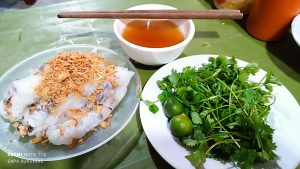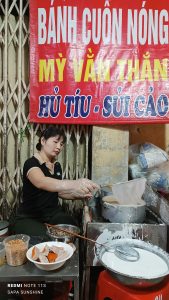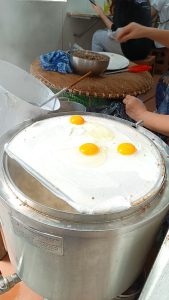Bánh Cuốn
The origin and culture of Banh Cuon
In the Vietnamese dictionary, Banh Cuon ( Banh Muot or Banh Uot) is the name of a dish made from thinly steamed rice flour rolled with meat or vegetable. A long time ago, Banh Cuon originated from Southern China to Northern Vietnam. In Vietnam’s history, Vietnamese used to eat Banh Cuon on the occasion of Tet Han Thuc. According to Vietnam’s historical migration, Banh Cuon was brought from Northern Vietnam to Southern Vietnam and abroad and has become a traditional dish of worldwide Vietnamese communities . Unlike Chinese rolls with a thick crust, coated on stainless steel pot and eaten directly by pouring soy sauce on top, Vietnamese rolls has a thinner crust, is usually coated on a boiler and requires eater to dip the piece of Banh Cuon into the dipping fish sauce.

Belonging to the paddy rice’s culture, Vietnamese Banh Cuon also shows cultural factors through the combination of yin yang ingredients such as green vegetables being the yin element, meat or shrimp being the yang element and the rice powder neutralizes those 2 properties, creating attractiveness for the dish. Moreover, there is a combination of five colors: green of vegetables, red of shrimp and meat, black of wood ear mushroom, yellow of fried shallots, and white of rolled crust of Banh Cuon. Moreover, the combination of dipping fish sauce’s flavor comes from the rich, sweet and sour taste of sugar and vinegar, the spicy taste of chilli peppers in the beautiful golden cup of fish sauce. The cultural combination through the elements of yin and yang, five colors, and flavors have created the typical characteristics of Banh Cuon. This dish is created not only by the cooking ingredients but also by the hands of the chef.
How to make basic Banh Cuon
Vietnamese Banh Cuon is basically a steamed rice roll filled with meat with wood ear, mushrooms, served with dipping fish sauce and fresh herb. The process of making Banh Cuon consists of 3 parts:
When making Banh Cuon, the ingredients are divided into 2 main parts: the crust and the filling. The crust is usually very thin, skillfully made from a mixture of rice flour, tapioca starch. To process the crust, a stirring mixture of rice flour, tapioca flour and water will be poured over and evenly applied over the thin cloth on the steamed boiler. The crust is made using the traditional method with a pot of hot water and layer of cloth on top. The steam rising from the boiling water below will quickly cook the rice flour and make the crust soft and moist. After that, this thin layer of powder will turn from white to transperant. This very thin layer is put over onto a plate with a bamboo stick. Finally, people will put the filling ingredients in the middle and roll them closed.

The filling ingredients of making Banh Cuon which are popular throughout the country, are pre-fried pork, chopped onion and dried mushrooms. All of these ingredients must be in a balanced ratio, seasoned to well taste with a little fish sauce and pepper to increase the flavor and attract aroma. In addition, green onions are chopped and fried to a crispy golden color to roll with the filling or sprinkle on a plate of Banh Cuon. Thanks to the thin and transparent crust, diners will easily notice the eye-catching colors of the delicious pork pieces emerging inside the soft rice flour crust. Coming with the plate of Banh Cuon is a bowl of dipping fish sauce lightly mixed with vinegar, sugar, chilli, black pepper and served with fresh herbs.
Types of Banh Cuon
Vietnamease Banh Cuon has many different versions, depending on each region. From Northern Vietnam, Banh Cuon eaten with broth is popular in the North East region such as Ha Giang, Cao Bang, Thai Nguyen, Lang Son and Hai Phong. Due to the usual cold climate, the dipping sauce is made from hot pork bone broth, can be added with little fish sauce, fresh green onions, coriander, Vietnamese ham. In these places, Banh Cuon is usually rolled in a larger size, eaten by soaking in a bowl of hot dipping sauce, to help warm the body in the cold weather of highland. In the Red River delta, Banh Cuon is thinly coated, served with a bowl of sweet and sour dipping fish sauce and with Vietnamese Cha ( like Banh Cuon Thanh Tri) or with grilled meat ( Banh Cuon Ha Nam) or with squid cake (Banh Cuon Quang Ninh). In addition, Banh Cuon rolled with with poached egg is aslo increasingly popular in the Northern region, due to its rich, fatty and fleshy taste, and is suitable for cold weather. In the Central Vietnam, Banh Cuon has many other more interesting versions. Banh Cuon Thanh Hoa are filled with shrimp and minced pork, often served with pure fish sauce and unfilled Banh Cuon is often served with eel porridge. When coming to Nghe An, Ha Tinh provinces, Banh Cuon is often called Banh Muot. If it is the filling type, it is similar to the basic Banh Cuon. If not, it is served with rolls, duck, beef, chicken, pork organs or with fried spring rolls. Coming from Hue province to the ending of Central Vietnam, Banh Cuon has another name: Banh Uot. In these areas, Vietnamese rolls without filling will be served with variety of fillings such as spring rolls, grilled meat, shrimp ( Banh Uot Hue), chicken intestines. The common feature of Banh Cuon is the Central region is that the sauce is less sweet and sour, with more pure fish sauce flavor than the Northern region. However, instead of the only usual dipping sauce, Banh Uot Ban Me also has dipping soy sauce and dipping Mam Nem sauce to diversify the taste of the client.

In the Southern Vietnam, Banh Cuon tends to be sweeter. Although Banh Cuon Sai Gon originates from the Northern Banh Cuon, it has many changes to suit the taste of Southerners such as sweeter dipping sauce, along with various types of filling served with bean sprouts, chopped herbs salad, shrimp cakes or spring rolls, beef rolls. Banh Cuon from the West South regions is processed in the form of sweet desserts. The roll is also coated on the steamer, but it has a more eye-catching color and is more fragrant thanks to coconut milk and natural coloring ingredients such as marigold leaves, beets, pandan leaves. Besides, the filling of the roll is also quite special because it is made from green beans, coconut, maybe taro. The outside Banh Cuon is also covered with a layer of roasted sesame, so the cake always has fatty, fragrant and sweet taste.
Banh Cuon in the life of Hanoian
Banh Cuon Hanoi has been taken place for many Hanoian generations from the past to the present. The most famous among all types of Banh Cuon must be Thanh Tri Banh Cuon. Writer Thach Lam once wrote Banh Cuon Thanh Tri in the book “Hanoi 36 Pho Phuong” This is the real gift: Banh Cuon, eaten with Vietnamese fatty pork hams, or with hot fried tofus. But Banh Cuon Thanh Tri is as thin as paper and as clear as silk. This Banh Cuon is fragant and smooth. The Banh Cuon without filling frugal but with the filling, this Banh Cuon is a richer taste, because of a little onion fat. The seller of Banh Cuon Thanh Tri with a bamboo basket on his head, in groups of five or seven people, walked into the street from Lo Lon, with a flexible and agile texture. In addition to Banh Cuon Thanh Tri, Banh Cuon filled with port, wood ear and shiitake mushrooms are also popular. The crust is hot right at the shop, rolled at the place so that diners can enjoy the hot flavor of the dish. Moreover, although egg Banh Cuon appeared only 20 years ago, they soon became popular after Banh Cuon without and with fillings. This Banh Cuon is very suitable to enjoy in cold times. In addition, Hanoi Banh Cuon’s dipping sauce has a sweet and sour taste. When eating, diners can sprinkle some pepper, 1 slice of chilli, squeezed lemon, kumquat or vinegar, which will help the dish have full flavor, creating more excitement when tasting Banh Cuon.
- ←
-
Email Us
Please send us an Email
